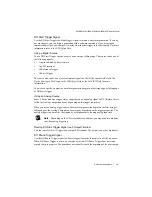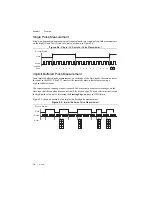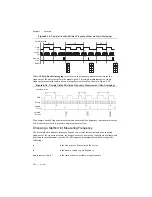
© National Instruments
|
5-5
NI cDAQ-9132/9133/9134/9135/9136/9137 User Manual
Controlling the Direction of Counting
In edge counting applications, the counter can count up or down. You can configure the counter
to do the following:
•
Always count up
•
Always count down
•
Count up when the Counter 0 B input is high; count down when it is low
For information about connecting counter signals, refer to the
section.
Pulse-Width Measurement
In pulse-width measurements, the counter measures the width of a pulse on its Gate input signal.
You can configure the counter to measure the width of high pulses or low pulses on the Gate
signal.
You can route an internal or external periodic clock signal (with a known period) to the Source
input of the counter. The counter counts the number of rising (or falling) edges on the Source
signal while the pulse on the Gate signal is active.
You can calculate the pulse width by multiplying the period of the Source signal by the number
of edges returned by the counter.
A pulse-width measurement will be accurate even if the counter is armed while a pulse train is
in progress. If a counter is armed while the pulse is in the active state, it will wait for the next
transition to the active state to begin the measurement.
Refer to the following sections for more information about cDAQ controller pulse-width
measurement options:
•
Single Pulse-Width Measurement
•
Implicit Buffered Pulse-Width Measurement
•
Sample Clocked Buffered Pulse-Width Measurement
Single Pulse-Width Measurement
With single pulse-width measurement, the counter counts the number of edges on the Source
input while the Gate input remains active. When the Gate input goes inactive, the counter stores
the count in the FIFO and ignores other edges on the Gate and Source inputs. Software then reads
the stored count.
















































